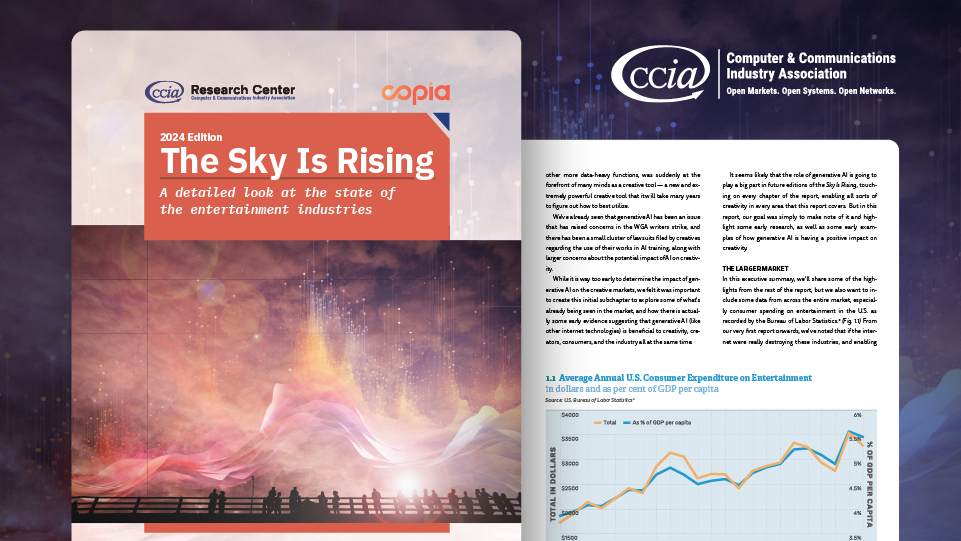What Can We Deduce from the Oscars About the State of the Movie Industry?
The Oscars this past Sunday night demonstrate the continuing vibrancy of the film industry, notwithstanding dire declarations of the harm online infringement causes.
The film industry is increasingly global, both in production and distribution. 60% of the industry’s $26 billion total gross in 2013 came from outside of the United States. The international box office is up 32% over the past five years.
Awards and nominees were similarly international. The winning movies 12 Years a Slave and Gravity were helmed, acted, and designed by numerous British and Mexican artists (e.g., Steve McQueen, Chiwetel Ejiofor, Benedict Cumberbatch, Mark Sanger, Alfonso Cuarón, Emmanuel Lubezki, among others). Gravity’s Oscar-winning director and editor, Alfonso Cuarón, delivered part of his acceptance speech in Spanish. Australians like Cate Blanchett won in three categories, and Europeans also dominated the live action and animated short awards.
The film industry is promoting a new generation of actors to appeal to new audiences. While some of the nominees in the best actor categories are industry veterans (e.g., Judi Dench, Meryl Streep, Sandra Bullock, and Julia Roberts), the industry is promoting a new generation of stars to compete for the attention of young audiences. For example, 23 year-old Jennifer Lawrence won the Best Actress award last year for Silver Linings Playbook and was nominated for Best Support Actress this year for American Hustle. At the same time, she starred in the two Hunger Games movies, which have grossed globally over $1.5 billion.
The film industry is embracing new technologies. Director Alfonso Cuarón delayed production of Gravity until technology could be developed to create the stunning visual effects that made the actors appear as if they were drifting weightless in space. Innovative uses of technologies such as 3-D, computer graphics, and digital sound provide audiences with fresh experiences that encourage them to go to the movies. The industry encourages the development of new technologies both through investment and recognition in a special awards ceremony.
Perhaps the clearest demonstration of the industry’s openness to new technology was the “selfie” Ellen DeGeneres organized with several of the top stars in the middle of the awards ceremony. Her stated objective was to have the most shared tweet on Twitter, a goal she quickly achieved. Indeed, the selfie was retweeted so much that Twitter briefly crashed. (See here for a discussion of who owns the copyright in the selfie.) As of the afternoon, the selfie had almost 3 million shares. This use of social media promotes the stars, the films they are in, and the Oscars as a cultural event. Speaking of which, 43 million viewers in the U.S. watched the ceremony, the largest audience for the Oscars in ten years.
The film industry is still producing a wide variety of films with high production values. Promoters of strong copyright protection concede that the Internet has enabled the creation and distribution of amateur content. They further acknowledge that disintermediation might benefit professional writers and performers, who can produce their own books and sound recordings and distribute them directly to the public via Internet platforms. But they always cite motion pictures with high production values as the type of creative content that can exist only in an environment with strong copyright protection given their high costs of production.
All this is true. And this year’s Oscars demonstrate that the existing level of copyright protection is sufficient to incentivize the creation of high production value films of enormous variety, from films that are part of popular franchises (e.g., Iron Man 3, Despicable Me 2, The Hobbit: The Desolation of Smaug, Star Trek Into Darkness) to those based on true events (12 Years a Slave, Dallas Buyers Club, American Hustle, Philomena, The Wolf of Wall Street, Captain Phillips, Lone Survivor) to those that portray events that could occur in the near future (Gravity, Her) to those centering of family relationships (Nebraska, August: Osage County, Blue Jasmine).
This year’s Oscars show that more than thirty years after the widespread distribution of the VCR, and more than twenty years after the popularization of personal computers and the creation of the World Wide Web, the film industry is thriving. This is thanks to the industry’s openness to talented artists from around the world, which in turn are able to develop a diversity of highly creative works that appeal to ever broader audiences. The continued success of the film industry depends on its artists, not its lobbyists.
Jonathan Band is a DC-based attorney whose clients include Internet companies, providers of information technology, universities, library associations, and CCIA. He previously guest-posted on DisCo about the future of fair use after Google Books.








